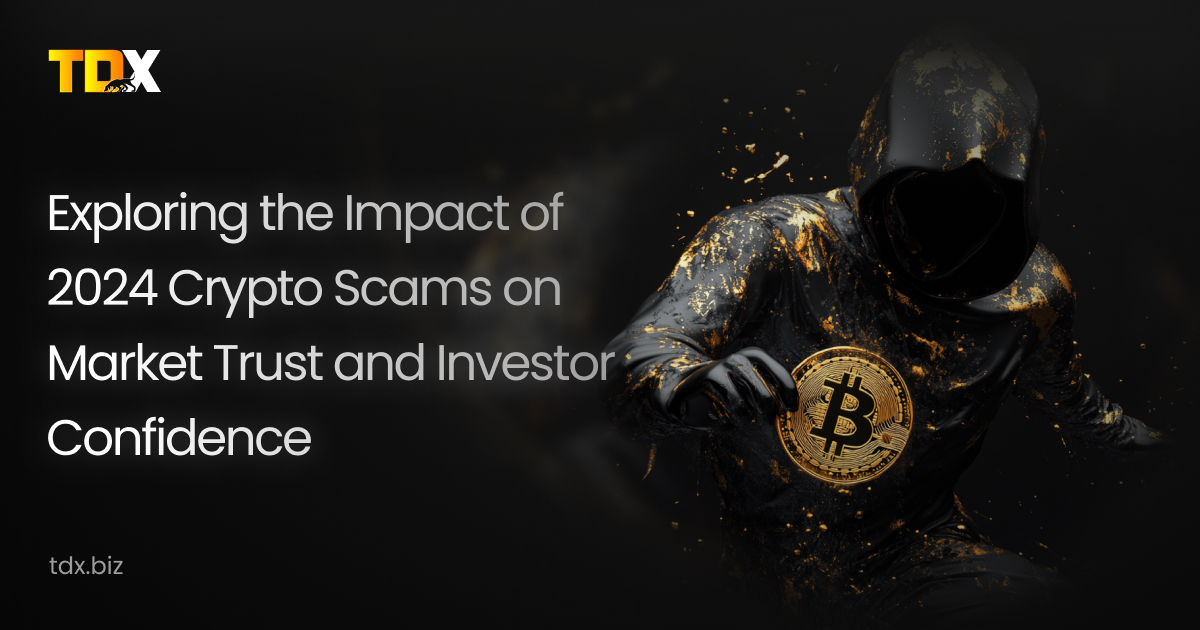 Back to blog
Back to blog


Exploring the Impact of 2024 Crypto Scams on Market Trust and Investor Confidence
Cryptocurrencies have seen tremendous growth over the past decade, attracting a diverse range of investors with promises of high returns and financial innovation. However, this burgeoning market has also become a fertile ground for scams and fraudulent activities. The year 2024 has been particularly notable for several high-profile crypto scams, which have significantly impacted market trust and investor confidence.
This detailed exploration delves into the various types of scams, their implications, and the necessary measures to restore confidence in the crypto market. Read on!
Overview of Crypto Scams
The cryptocurrency market in 2023-34 experienced a notable decrease in overall illicit activity, with significant drops in money laundering and stolen funds. However, scams, especially those utilizing advanced techniques such as deepfakes and AI-generated content, have continued to pose substantial threats to investors. These scams have grown in complexity and frequency, eroding trust and confidence in the market.
Source: Chainalysis 2024 Crypto Crime Report
High-Profile Scams and Their Impact
1. Coinseed Scam
Coinseed, a cryptocurrency trading platform established in 2017, quickly gained popularity for its user-friendly interface, especially among younger and novice investors. However, in February 2021, the platform was sued by the SEC and the New York Attorney General for selling an illegal security (CSD token), falsifying executive credentials, and failing to disclose investor fees. The legal actions culminated in the platform’s shutdown in September 2021, leading to significant financial losses for its users.
The fallout from the Coinseed scandal had lasting effects on investor behavior. Victims of the scam reduced their investments in other crypto platforms by approximately 36.5%, highlighting a significant shift in investment strategies due to diminished trust.
2. Romance Scams
Romance scams, often referred to as “pig butchering,” have become increasingly prevalent. Scammers build relationships with victims over time, eventually convincing them to invest in fake opportunities. These scams not only result in financial losses but also cause significant emotional and psychological damage. The number of romance scams has grown significantly, with revenue from such scams doubling year-over-year.
Source: Chainalysis 2024 Crypto Crime Report
3. Ransomware Attacks
Ransomware attacks have continued to target high-profile institutions, including hospitals, schools, and government agencies. These attacks have resulted in over $1 billion in extorted cryptocurrency payments in 2023 alone. Despite a general decline in other forms of illicit activity, ransomware remains a persistent and growing threat.
Source: Chainalysis 2024 Crypto Crime Report
Financial Literacy and Investor Response
The role of financial literacy in shaping investor responses to crypto scams cannot be overstated. Our research indicates that investors with higher financial literacy significantly reduce their investments in other crypto platforms after experiencing fraud. In contrast, those with lower financial literacy are more likely to fall victim to future scams, underscoring the need for enhanced investor education and protection.
Crypto scams do not only affect the cryptocurrency market. There is evidence of spillover effects on traditional capital markets as well. Victims of crypto fraud tend to reduce their investments in traditional markets, indicating a widespread loss of trust in the financial system. This phenomenon suggests that crypto fraud has broader implications for financial stability and investor confidence across multiple domains.
The Path Forward
To combat the increasing sophistication of crypto scams, a multi-faceted approach involving enhanced regulation, advanced technological tools, and comprehensive investor education is essential.
- Stronger Regulatory Oversight
Governments and regulatory bodies must establish clear and consistent frameworks to oversee crypto activities. This includes cracking down on fraudulent platforms and ensuring that legitimate businesses comply with rigorous standards. - Enhanced Investor Protections
Implementing measures such as insurance for crypto assets and mandatory disclosures can help protect investors. Education programs aimed at improving financial literacy and awareness of potential risks are equally important. - Technological Advancements
Continued development and deployment of sophisticated tools for monitoring and analyzing blockchain transactions are crucial. These tools can help detect and prevent illicit activities more effectively. - Community Engagement
Encouraging a culture of transparency and accountability within the crypto community can foster trust. Projects should be encouraged to maintain open lines of communication with their investors and provide regular updates on their progress and challenges.
Conclusion
The impact of crypto scams in 2024 underscores the urgent need for enhanced regulatory frameworks, investor education, and advanced technological tools to protect the integrity of the cryptocurrency market. While the potential for high returns and financial innovation in the crypto space remains significant, the prevalence of scams poses a substantial risk. By addressing these challenges through a comprehensive approach, the crypto market can rebuild trust and ensure a safer environment for all investors.
40,000 readers 🚀 are getting insights with our media
 Read on Medium
Read on Medium 

Article
“Is Ethereum dead?” This is a trending argument that is appearing in various crypto communities and media. Which is not…


Guide
Welcome to the beginner’s guide on Trust Wallet, MetaMask, and Exodus—three most common cryptocurrency wallets for managing your crypto assets….


Article
When Venezuela’s inflation hit 189.8% in 2023 [Central Bank of Venezuela, 2023], Maria’s life savings of 200 million bolivars (enough…


Article
For generations, Indians have trusted one investment: fixed deposits (FDs). If you walk into any Indian household, chances are someone…


